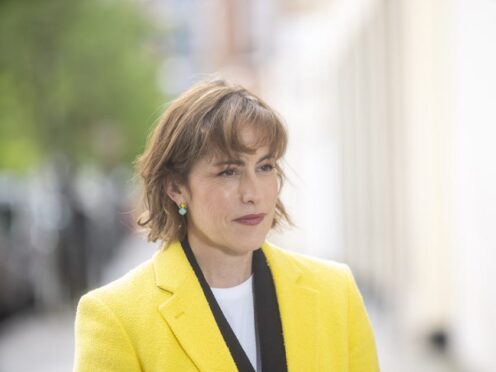The term “woman” should not be “eradicated from our language in order to be inclusive and welcoming”, the Health Secretary has said as she announced plans to overhaul the NHS constitution to “ensure that biological sex is respected”.
Victoria Atkins said changes to the NHS Constitution will ensure language used in the health service is “clear” so that pregnant women are not referred to as “service users” to bolster inclusivity.
The Department of Health and Social Care said it is “defining sex as biological sex” with the new document, which underpins NHS care.
Proposed changes will also ensure hospital patients in England have the right to request to be treated on single-sex wards, with transgender people placed in rooms on their own.
But the British Medical Association warned the proposed changes could mean transgender and non-binary patients “potentially find their access to vital NHS services limited” while the Royal College of Nursing said changes to health policy should be done with patients “not unto them”.
Officials said that the update “is about putting patients first” and includes plans to accommodate requests for same-sex intimate care.
Ms Atkins told Sky News: “We have said in the consultation that we would like language to be clear.
“We know that in some parts of the NHS some language is used which is meant with the best of intentions to include, be inclusive, but it can, I think, also actually exclude people.”
She added: “For example, I visited a wonderful maternity unit recently full of warmth and joy and happiness with wonderful members of staff, but they were talking about ‘service users’ and I realised after a while they meant women or mums-to-be or mothers – the language that we would use in conversation when talking about someone having a baby.
“So that sort of language … we shouldn’t have to eradicate women from our language in order to be inclusive and welcoming.
“If somebody walks in and they want to have a specific phrase or term used, of course we respect that, but it’s also about ensuring that biological sex is respected.”
She told Times Radio: “There will be listeners who are worried about the fact that they see articles in the paper about ‘chestfeeding’ and language such as that.
“We want language to be clear and make sense to people.”
Under the planned revisions, transgender people could be placed in a room on their own if another patient requests to be in a single-sex ward.
This would be permitted under the Equality Act 2010 when appropriate, “such as respecting a patient’s wish to be in a single-sex ward”, Government officials said.
In October, former health secretary Steve Barclay said he would look into changing the constitution to address concerns about trans women using wards intended for biologically female patients.
Ms Atkins told Sky News: “We want to ensure that biological sex is respected and that if someone wants, for example, to have an intimate examination by a person of the same biological sex, then they can make that request and it is dealt with appropriately, and with respect and recognising that person’s right to privacy and dignity and safety.”
She said in a statement: “We have always been clear that sex matters and our services should respect that.
“By putting this in the NHS Constitution we’re highlighting the importance of balancing the rights and needs of all patients to make a healthcare system that is faster, simpler and fairer for all.”
Maya Forstater, chief executive of Sex Matters, a human rights charity that campaigns for clarity on sex in law, policy and language, said: “Victoria Atkins explicitly referring to biological sex is very significant.
“It will benefit anyone who needs same-sex intimate care in the NHS in England, or who may do so in the future.
“We can expect an outraged response from trans rights activists, but this is simply a return to common sense, and an overdue recognition that women’s wellbeing and safety matter.”
Shadow health secretary Wes Streeting said “rights on paper are worthless unless they are delivered in practice”.
He added: “The NHS Constitution already pledges that no patient will have to share an overnight ward with patients of the opposite sex, but that is not the case for too many patients.
“Labour supports single-sex wards and will provide the staff, investment and reform the NHS needs to make sure every patient can be cared for safely.”
Professor Nicola Ranger, chief nursing officer and deputy chief executive of the Royal College of Nursing (RCN), said: “Trans and non-binary patients are deserving of high-quality care like any other patient and changes to health policy should be done with them, not unto them.”
Dr Emma Runswick, deputy chairwoman of the British Medical Association (BMA) council, warned some changes “run the risk of causing more harm than good – with the potential to incite further discrimination, harassment and ostracisation of an already marginalised group”.
“If these proposed changes come into effect, transgender and non-binary patients will potentially find their access to vital NHS services limited,” she added.
The NHS Constitution outlines the rights of patients and staff and is updated every 10 years.
Other proposed changes, which are subject to an eight-week consultation, include committing to providing families with a second opinion when a patient’s condition is deteriorating.
The rollout of the escalation process, also known as Martha’s Rule, started earlier this month and follows the death of 13-year-old Martha Mills in 2021.
She developed sepsis after suffering a pancreatic injury following a fall from her bike.
Martha’s parents, Merope Mills and Paul Laity, raised concerns about their daughter’s health a number of times but these were brushed aside.
A coroner ruled she would most likely have survived if doctors had identified the warning signs of her rapidly deteriorating condition and transferred her to intensive care earlier.
The new constitution will also reinforce the health service’s commitment to unpaid carers and will aim to reduce inequalities in access among different groups.
